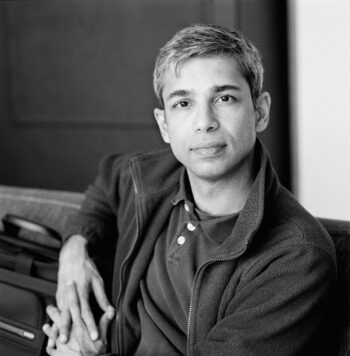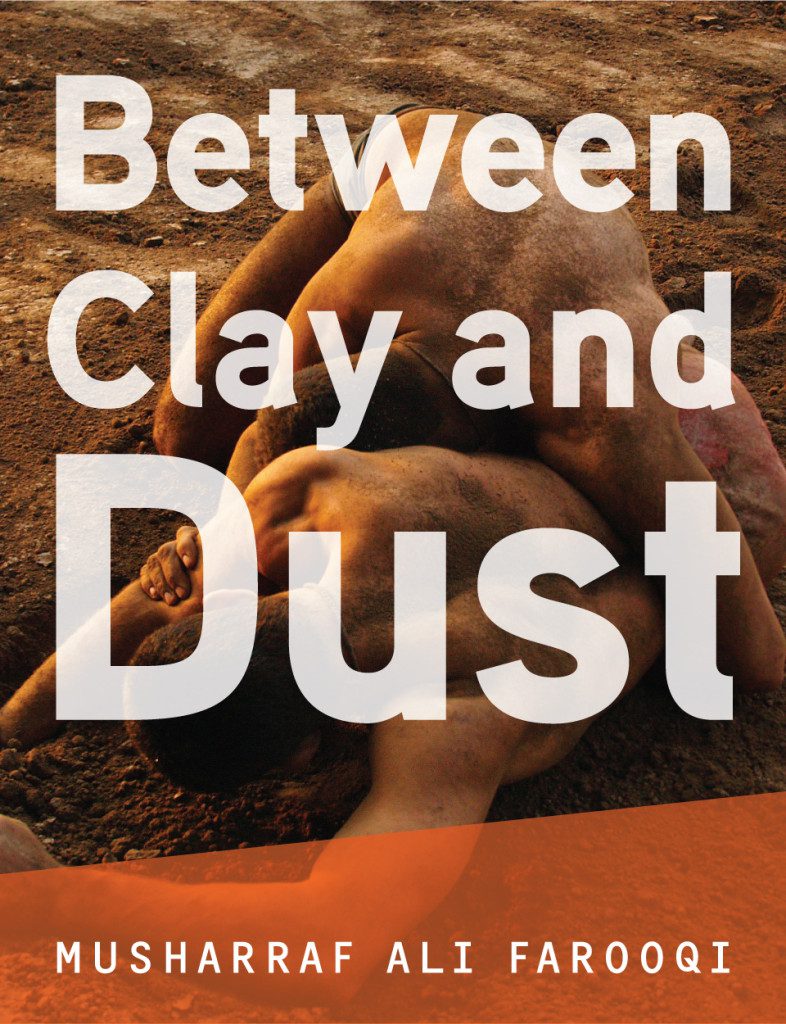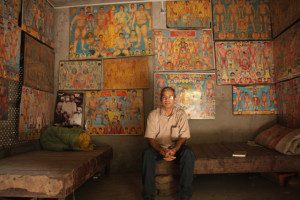
What happened to art and artists, when India and Pakistan gained their independence in 1947? What happened to common social values? In Musharraf Ali Farooqi’s fable-like Between Clay and Dust, two older artists find themselves thrust into an almost unrecognizable life post-Partition. The champion pahalwan Ustad Ramzi struggles to defend his clan’s honor against corrupt promoters and a rebellious younger brother. The courtesan, Gohar Jan, watches her life deteriorate.
Between Clay and Dust was shortlisted for The Man Asian Literary Prize 2012 and long-listed for the 2013 DSC Prize for South Asian Literature. When Musharraf is not writing, he is translating Urdu into English, or working on his recently launched children’s book publishing company Kitab.
I reached Musharraf, a polite, soft-spoken man, in Lahore, Pakistan via e-mail and also by phone. We discussed his new novel, how translation has informed his writing, and why the slender book (216 pages) took ten years to write.
***
The Rumpus: The main protagonist of Between Clay and Dust is Ustad Ramzi, an older professional wrestler, who heads a wrestling organization. What initially drew you to this subculture and to this character?
Musharraf Ali Farooqi: The novel began as a literary essay, much like Borges’s essay on Shakespeare, on the idea of the pahalwan (wrestler) in the Indian tradition, although it was not to focus on any particular character. In the Indian tradition, wrestling is not merely a sport but a code of life. It transcends the status of a sport and becomes an art. The closest parallel is to be found in the Japanese tradition of the sumo. However, unlike the sumo wrestlers, the pahalwan are extremely agile, and superb athletes; the toughest in the world, I believe. Unlike other athletes, a pahalwan remains in the state of complete preparedness all his life. Some become celibate so as to devote themselves entirely to the life of a pahalwan. I wished to explore what effect it has on the mind and soul of an artist who undergoes its severe discipline for decades. When I started reading about the pahalwans and their history in India and Pakistan, it opened a window into their lives, and the subculture. And as you read history, the characters begin to take shape—the world they move in emerges. The novel grew out of that world.
Rumpus: Do the pahalwans exist today?
 Farooqi: Yes, in both India and Pakistan, though, as the novel suggests, much has changed since the late 19th and early 20th century, which was the great time for this art form. Prior to Partition, the pahalwan was of great value to a court or prince or king, who considered it an honor to have a great warrior attached to their court. Such a warrior represented the glory of the court. Now, it’s more of a sport, with spectators who pay money to watch the fight. Prior to Partition, it would be a great accomplishment for a pahalwan to defeat an opponent in the shortest possible time. Now, when I go, I, like, all spectators, want value for my money. If the fight is over in a half second, where is the meat in that?
Farooqi: Yes, in both India and Pakistan, though, as the novel suggests, much has changed since the late 19th and early 20th century, which was the great time for this art form. Prior to Partition, the pahalwan was of great value to a court or prince or king, who considered it an honor to have a great warrior attached to their court. Such a warrior represented the glory of the court. Now, it’s more of a sport, with spectators who pay money to watch the fight. Prior to Partition, it would be a great accomplishment for a pahalwan to defeat an opponent in the shortest possible time. Now, when I go, I, like, all spectators, want value for my money. If the fight is over in a half second, where is the meat in that?
Rumpus: In addition to the world of wrestling, you have a parallel storyline that takes the reader into the world of courtesans who cater to the nobility of South Asia. Your main character in this storyline is Gohar Jan. How did you immerse yourself in her world?
Farooqi: I studied the lives of courtesans. Not much has been written about them, but whatever is available tells us they played a prominent role in society in the nineteenth century and early twentieth century India. Their kothas (parlours) were the abode of the nobility. They were the arbiters of high culture, and were excellent poets, singers, and dancers. Again, a close parallel can be drawn with the institution of the geisha. But the Indian courtesan was in some ways more autonomous. They no longer exist today.
Rumpus: You intentionally left the country unnamed. We do learn, however, “The ravaging winds of Partition had left it unscathed,” which references the partition of India and Pakistan in 1947. Will you talk about your decision to leave the place unnamed? How is it linked to your desire to create a certain tone?
Farooqi: For me this novel was about the common culture of the Indian subcontinent as it existed before the Partition. The Partition does plays a part in how the resultant abolition of princely states affected the fortunes of the two artists, and how there is a breakdown of values once the society’s common values are questioned by a political event. This vagueness allowed readers in both India and Pakistan to imagine the story in their own immediate worlds. I’ve heard from readers in both countries, and it is gratifying for me that Indian readers think the story takes place in India, and Pakistan readers think it takes place in Pakistan.
Rumpus: Can you elaborate on the breakdown of these common values? Both of the fading artists in your novel yearn for the time prior to Partition, when values such as loyalty, discipline, honor, and respect prevailed. Are you referring to these common values?
Farooqi: Partition called into question the basic societal value of acceptance of the Other, which developed over time and through a long period of conflict, to create an integrated multi-faith society. These values took time evolving and were a strength of the Indian society for centuries. Those values were challenged with Partition and the idea that Hindus and Muslims are so different that they could not co-exist; that Muslims should have a different homeland because those compromises, which had kept the society together for the longest time, were no longer possible. Now we have the agendas of the nation-states driving these divisions, but there was a time when the leaders of our common society were driving that agenda and that was the real tragedy.
Once the old value system fell, people were free to demonize anyone. What is happening in Pakistan—the sectarian violence, the ethnic violence, the religious violence—is a continuation of this inability to come to terms with anyone other than a very self-righteous and narcissistic image of the self, which is always unreal and false.
Rumpus: Both Ustad Ramzi and Gohar Jan have an allegiance to a bygone time. Do you have nostalgia for a bygone time? Is there something the present can learn from the past?
Farooqi: Yes and no. I do feel nostalgic about a period when the literary sense or the love of language was integrated in our lives and literary expression was a natural part of human communication with oneself. There was such a time in India, and in the history of the Urdu language, when it was the common language of a great number of people in India and did not represent any particular religious identity as it does now—again, thanks to the Partition politics. But I do not feel nostalgic about the past. I think we have it better now. Much better. In all respects.
Rumpus: The world of Ustad Ramzi, the older wrestler, is at odds with his younger brother’s. In the new world of wrestling, there are promoters who fix fights to make money and supply fighters with drugs. I found the relationship between these two very powerful. Can you talk about the differences between their viewpoints?
Farooqi: Ustad Ramzi takes an idealistic view of things, and then there is the matter of his principles. The idealism is understandable because he grew up in a time when a world existed that could sustain those ideals. That world is no longer there when the novel opens, but we can sympathize with his bafflement. The discomfort comes when we find that some slight relaxation or compromise on his principles is always possible in his personal life, but these same principles are severely applied where others are concerned. And that is the thing with principles, which are always a code built around a person or a group’s comfort. Tamami is unable to figure this out intellectually, but he feels the injustice of his situation instinctively, and perhaps the reader does, too. And though Tamami is manipulated by others in making certain decisions, he is better able to grasp the situation facing his art than Ustad Ramzi.
Rumpus: You speak both English and Urdu, though Urdu is your native language. You write in English, yet in this novel, you use many Urdu words. They are not defined, though they are used in context: “Ustad Ramzi was the head of a pahalwan clan and the custodian of a wrestler’s akhara.” How does the use of foreign words contribute to the story? The tone? Did you waver on whether to translate these words into English?
Farooqi: I learned to properly read literature written in English when I was in high school. I started writing in English when I was at the university. But I could read and understood functional English long before that. Pakistan has a number of English language newspapers. You encounter English every day in Pakistan, in offices.
As to whether I should include Urdu words, I made the decision after much wavering. The moment one utters the word “wrestler,” it brings to mind the image of the culture and characters from the World Wrestling Federation (WWF) and it is a very different world from the world of the pahalwans. So I finally decided to retain the original terms in most cases. The real challenge lies in the dialogue though, because they had to sound right to the ears of someone who speaks Urdu as the first language.
Rumpus: How did you solve the challenge of dialogue?
Farooqi: If a word is off, the dialogue doesn’t sound right.
Rumpus: Do you read the dialogue out loud?
Farooqi: I read with my ears. So the auditory element is there.
Rumpus: You said in an interview that you now think in English. When did that happen? How did it affect your writing?
Farooqi: At first I was not aware of the transition from thinking in Urdu to thinking in English. It was because I also translate from classical Urdu into English. So translation was a natural activity for my mind. My wife’s first language is English and we speak English at home. She would sometimes ask me which language I thought in and I could never answer with certainty. Then I began to catch myself thinking in English.

I will say that my choice of English as the language for writing my fiction has made writing easier for me, in a manner of speaking. The shades of meaning available in Urdu are much greater than English. The usage authority for words in the Urdu language is derived from poetry. That means the language is very grounded in poetic works. For the classical Urdu poets, the ability to play on the shades of meaning in a word was valued very highly, and Urdu language has developed with that inherent consciousness. In Urdu, I am aware of the almost endless possibilities of structuring a sentence. Making aesthetic choices are a struggle for a writer in any language, but I know that it would have been far more difficult to be satisfied with, or settle on one, had I been writing in Urdu.
Rumpus: You translate Urdu classics into English, like The Adventures of Amir Hamza and the first book of a projected 24-volume magical fantasy epic, Hoshruba. How has your work as a translator affected your writing?
Farooqi: In a very fundamental way, I think. When you translate something, you spend hours and hours on one page. Sometimes in frustration, because it’s just not working. Then you realize why something is there. You see and understand the narrative devices. Because I translate from both classical Urdu and from Urdu poetry, the amount of time spent studying the hidden narrative devices in these texts provides a certain awareness and insight into how narratives work.
Rumpus: You wrote an essay about this, citing fate and predetermination as driving forces in a story. Did you tap into the knowledge of these narrative devices or others in the novel?
Farooqi: I did not. But if you are a sprinter and run one hundred meters, you must also weight train. The weight training helps you build those muscles for running. So I think the consciousness of these devices exists and it is useful for a writer to have it embedded in his consciousness.
Rumpus: There is deep affection between Ustad Ramzi and Gohar Jan. I don’t want to give away the ending, but I wondered if it was difficult to find the right ending. Did you write different versions?
Farooqi: The ending did not change in the many drafts I wrote. But I did struggle with how to execute it before the reader becomes aware of where the story was headed. I now think that it does not matter whether or not the reader can guess the ending, but when I was writing the novel I did worry about it.
Rumpus: I read that the book took you ten years to write, because you weren’t sure of the narrative voice. Can you talk about the struggle? Did you try out different voices? How did you finally settle on this voice, which has a fable-like feeling to it?
Farooqi: Yes the narrative voice eluded me for a very long time. Even at times when I had employed it in earlier drafts, I could not tell that it was the right voice. I did not have the confidence as a writer to know that there was no other way to tell the story. I kept thinking that maybe there was another way. At one point I also thought about introducing Death as a character, and telling the story in the voice of Death. You will find its remnants in the first chapter. Here is part of the opening:
The inner city had been emptied of most of its old inhabitants. Just as its walls had been stripped of their turquoise-colored mosaic panels, time’s ravages had forced into oblivion the generations of the dead, too. To answer the fierce demand for construction material during the last few years, the memory of those who had shaped the inner city was not only stripped of the tombstones that commemorated their existence, but also the bricks that marked their graves.
But throughout this struggle, I knew that the narrative voice was central to the story. It is because of this voice that I was able to compress the story in a relatively small length, for it could easily have been a novel three times its size.




